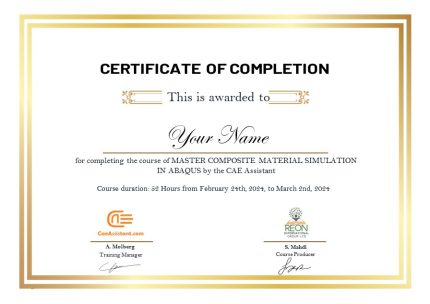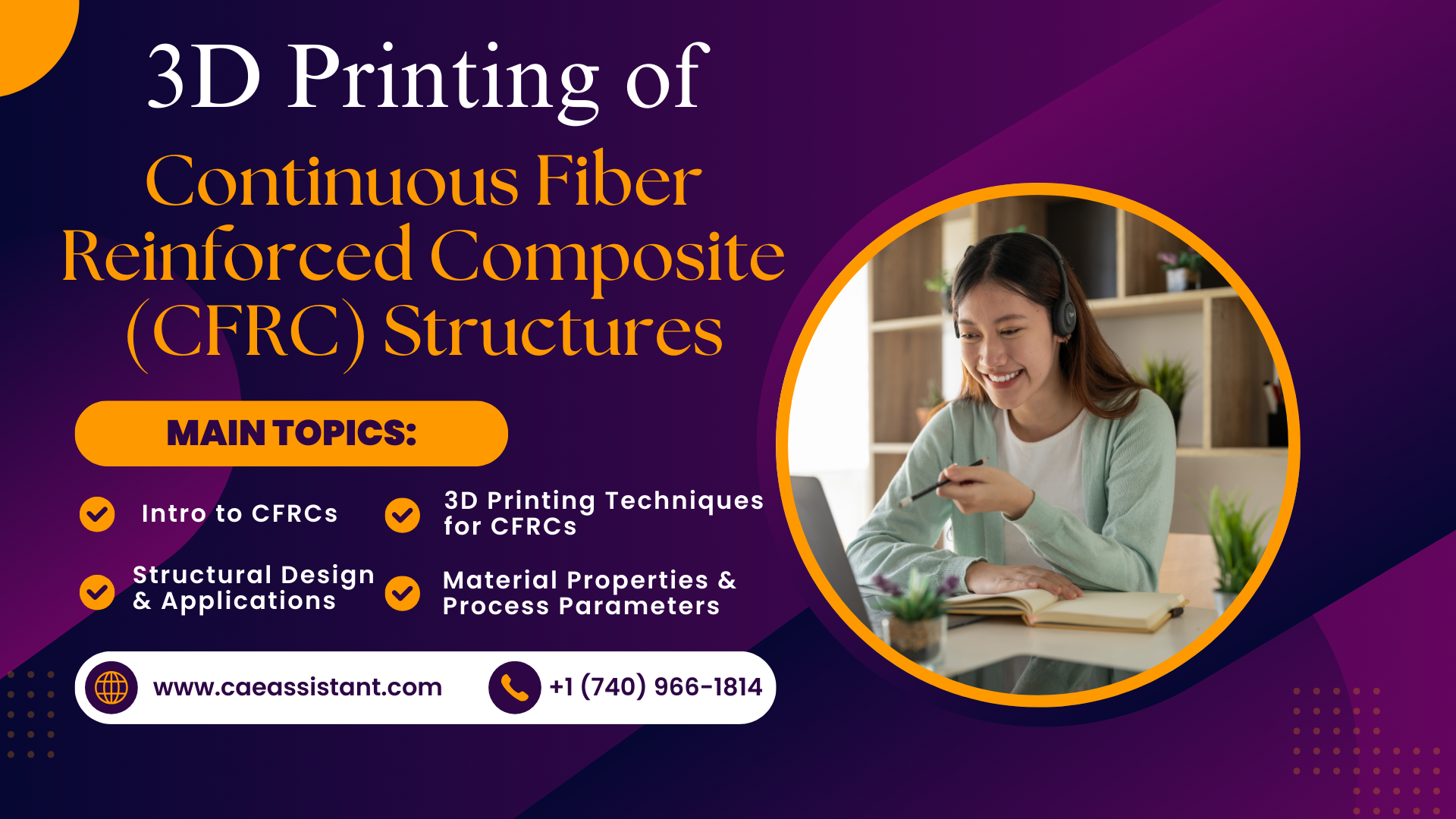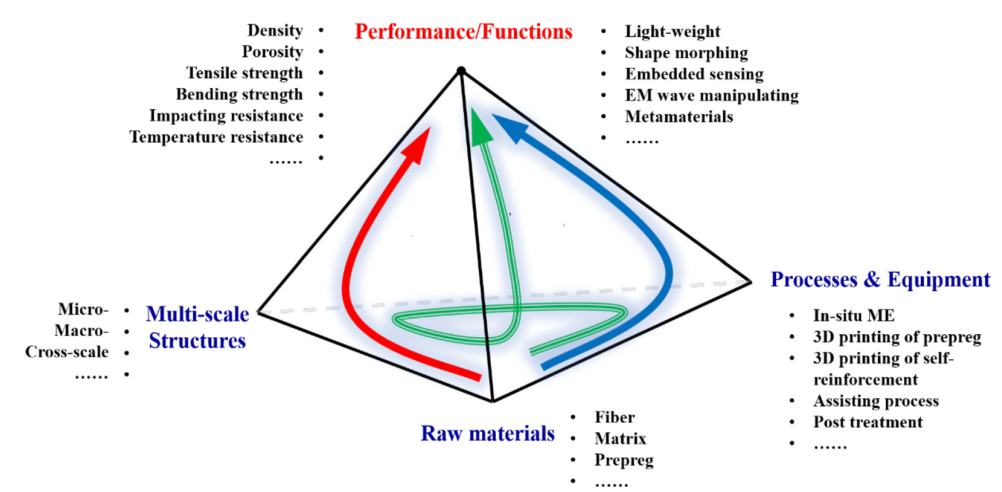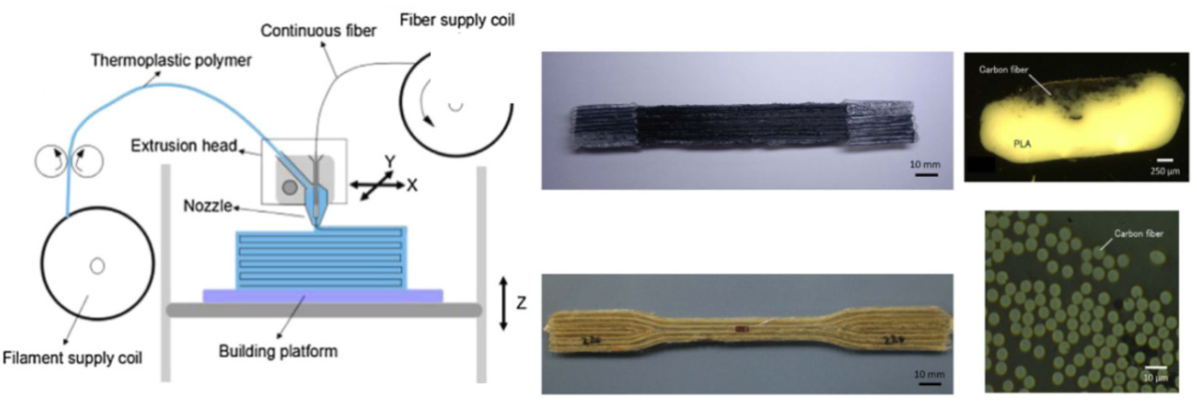This course explores the cutting-edge techniques in the 3D printing composites with continuous fiber reinforced Structures (Composite Fiber Reinforced Structures CFRSs), focusing on the multi-level design, fabrication, and innovative applications of these advanced materials. Participants will gain insights into the latest additive manufacturing methods, material choices, and structural optimization strategies that drive the development of CFRSs. Through a combination of theoretical knowledge and practical case studies, the course will cover the mechanical properties, design challenges, and future directions for 3D printed CFRSs, equipping students with the skills to leverage these materials in high-performance applications.
Let’s see the main topics and understand them with a simple intro to each one. Remember! this content is just a glance of the course for you to understand the topics of the course and you can see the full syllabus of the course in the Content tab.
The main topics are:
1. Introduction to Continuous Fiber Reinforced Composites (CFRCs)
Continuous Fiber Reinforced Composites (CFRCs) combine continuous fibers, such as carbon, glass, or Kevlar, with a polymer matrix. This results in materials with exceptional strength and stiffness. These composites are highly valued in industries like aerospace, automotive, and marine. For example, in aerospace, CFRCs make up over 50% of the material in advanced aircraft like the Airbus A350XWB. This significantly reduces weight and improves fuel efficiency. Similarly, in automotive and marine applications, CFRCs create lighter, stronger components, enhancing performance and durability.
Comparison Between Traditional Manufacturing and Additive Manufacturing (AM) of CFRCs
Traditional CFRC manufacturing methods, such as lay-up and filament winding, are labor-intensive and offer limited design flexibility. Additive Manufacturing (AM), especially 3D printing, provides significant advantages. It allows for complex geometries and optimized structures. AM also enables precise control of fiber orientation, resulting in better mechanical properties and less material waste. This approach is more cost-effective and sustainable than traditional methods.
2. 3D printing composites with continuous fiber reinforced structures
3D printing composites with continuous fiber involves using material extrusion techniques, like Fused Filament Fabrication (FFF). These methods integrate continuous fibers into a thermoplastic matrix during printing. This enables the creation of reinforced composite structures, layer by layer. Controlling fiber placement and orientation during printing is crucial for enhancing the final product’s mechanical properties.
Fused Filament Fabrication (FFF) for Continuous Fiber Reinforced Structures
FFF is a common method for 3D printing composites with continuous fiber. Continuous fibers are fed through a nozzle along with a thermoplastic filament, such as PLA or nylon. This process embeds the fibers within the matrix, reinforcing the material and improving mechanical properties. FFF allows precise control over fiber orientation, which is key to optimizing the strength and stiffness of the printed parts.
Advantages and Limitations of Current CFRC Printing Techniques
3D printing with continuous fiber techniques offers several benefits, including the ability to produce lightweight, high-strength structures with complex geometries. However, challenges remain, such as achieving consistent fiber-matrix bonding, controlling void content, and maintaining high printing speeds. These limitations are areas of ongoing research aimed at improving the performance and reliability of CFRCs.
Figure 1: Challenges in 3D Printing Composites with Continuous fiber [Ref]
3. Materials, Mechanical properties, and Process Parameters in 3D printing of CFRCs
The choice of fibers and matrix materials is crucial in determining CFRCs’ mechanical properties. Carbon fibers are often used for their high strength and stiffness, while glass fibers offer a cost-effective solution with good mechanical properties. The matrix material, typically a thermoplastic like nylon or PEEK, must bond well with the fiber to ensure adequate load transfer.
Optimization of 3D Printing and Slicing Parameters
Optimizing printing parameters, such as temperature, speed, and layer height, is essential for achieving the desired mechanical properties in CFRCs. Proper control of these parameters ensures good fiber-matrix bonding, reduces void content, and improves overall performance. Slicing parameters, including print orientation and support structures, must also be carefully chosen to enhance mechanical properties.
Impact of Material and Process Choices on Mechanical Properties
CFRCs’ mechanical properties, such as tensile strength, modulus, and fatigue resistance, are influenced by material choices and printing parameters. For example, higher temperatures can improve layer bonding, while proper fiber orientation enhances load-bearing capacity. Understanding the relationship between materials and process parameters is vital for optimizing CFRC performance.
4. Structural Design and Optimization of CFRCs
Designing CFRC structures involves moving from 2D fiber placement strategies to complex 3D designs. This multi-level approach creates optimized structures with enhanced mechanical properties. By controlling fiber orientation and distribution, designers can create structures that are both lightweight and strong, meeting the specific demands of high-performance applications.
Influence of Cell Geometrics, Patterns, and Filling Density on Mechanical Performance
The geometry and pattern of fibers, as well as the filling density within a composite, significantly impact the mechanical performance of CFRCs. Honeycomb and lattice structures are commonly used to maximize strength-to-weight ratios. Adjusting the filling density allows for fine-tuning properties like stiffness and impact resistance, enabling the design of robust yet lightweight components.
Path Planning and Structural Optimization for Customized Performance
Path planning in 3D printing composites with continuous fiber involves determining the optimal fiber trajectory to enhance mechanical properties. By aligning fibers along paths that follow principal stress directions, stronger, more deformation-resistant parts can be created. Structural optimization techniques, such as topology optimization, further refine the design by minimizing material use while maintaining or improving performance.
Figure 2: Schematic of 3D Printing Composites with Continuous fiber Reinforced [Ref]
5. Case Studies, Applications, and Future perspectives in CFRCs 3D printing
CFRCs are already being used in aerospace, automotive, and sports industries for their ability to produce lightweight, high-performance components. For instance, aerospace companies use CFRCs to reduce aircraft weight, improving fuel efficiency. In the automotive industry, CFRCs help develop lighter, stronger parts that enhance vehicle performance and safety.
Future Trends and Technological Innovations in the Field
The future of 3D printing composites with continuous fiber lies in further improving material properties and process efficiency. Innovations such as advanced matrix materials, better fiber-matrix bonding techniques, and more efficient printing methods are expected to enhance CFRC capabilities. These developments will expand the range of applications, solidifying CFRCs as a key material in high-performance industries.
Also, we have this course as well: “4d printing composite“
– Overview of CFRCs: Definition, Properties, and Applications.
– The Role of CFRCs in Aerospace, Automotive, and Marine Industries.
– Comparison Between Traditional Manufacturing and Additive Manufacturing (AM) of CFRCs.
– Overview of 3D Printing Methods for CFRCs.
– Fused Filament Fabrication (FFF) for Continuous Fiber Reinforced Structures.
– Advantages and Limitations of Current CFRC Printing Techniques.
– Selection of Continuous Fibers and Matrix Materials.
– Optimization of 3D Printing and Slicing Parameters.
– Impact of Material and Process Choices on Mechanical Properties.
– Multi-Level Design: From 2D to 3D Structures.
– Influence of Cell Geometrics, Patterns, and Filling Density on Mechanical Performance.
– Path Planning and Structural Optimization for Customized Performance.
– Analysis of Mechanical Behavior: Strength, Modulus, and Fatigue Resistance.
– Strategies to Enhance Mechanical Properties Through Design and Material Selection.
– Experimental and Simulation Methods for Evaluating Mechanical Performance.
– Shape Morphing Capabilities of 3D Printed CFRSs.
– Self-Monitoring and Smart Structures in CFRC Applications.
– Case Studies: Applications in Aerospace, Automotive, and Beyond.
– Current Limitations in Processing and Design.
– Bridging Gaps Between Advanced Manufacturing Processes and Design Requirements.
– Future Research Opportunities in CFRS Design, Fabrication, and Application.
– Real-World Applications of 3D Printed CFRSs in High-Performance Industries.
– Lessons Learned from Industrial Adoption of 3D Printing Techniques for CFRSs.
– Future Trends and Technological Innovations in the Field.
Our team of CAE Assistant instructors, renowned experts in their respective domains, will deliver each section of the course, providing you with unparalleled knowledge and insights.
Currently, the course instructor is being finalized, but we are committed to bringing you one of the leading experts in the field. We’re working diligently to ensure that a top researcher will be selected to develop and deliver this course soon.
Our courses are designed for a diverse audience that includes graduate and PhD students, R&D professionals in industry, and university faculty members. Each course is meticulously crafted based on the latest ISI papers and cutting-edge research to ensure that participants receive the most current and relevant knowledge in emerging technology topics.
Graduate and PhD Students: These courses provide advanced insights and practical applications of recent research, equipping students with the latest knowledge and methodologies to enhance their academic work and research capabilities.
R&D Employees: For professionals working in industrial research and development, our courses offer valuable updates on new trends and technologies, fostering innovation and enhancing their ability to address complex challenges in their projects.
University Faculty Members: Academics seeking to stay abreast of the latest developments will benefit from our courses by gaining access to cutting-edge research and emerging technologies, which can be integrated into their teaching and research activities.
By participating in our courses, all these groups will gain a competitive edge through up-to-date knowledge, practical skills, and insights directly derived from the forefront of scientific and technological advancements.
Finite Element Analysis course Certificate
Upon successful completion of this course, you will receive a course completion certificate. This certificate guarantees your skills with the amount of time spent, skills trained, and can be verified online.

Taking the “Advanced 3D Printing of Continuous Fiber Reinforced Composite Structures” course can lead to several specialized job opportunities, including:
- Additive Manufacturing Engineer: Design and optimize 3D printing processes for continuous fiber reinforced composites, focusing on producing high-performance structures for aerospace, automotive, and marine industries.
- Materials Engineer: Develop and select appropriate continuous fibers and matrix materials for 3D printing, enhancing the mechanical properties and performance of printed composite structures.
- Design Engineer: Specialize in structural design and optimization of 3D printed composite parts, using advanced software to create customized, high-strength components with optimal geometries.
- R&D Engineer: Conduct research to push the boundaries of CFRC 3D printing technology, focusing on overcoming current limitations and exploring innovative applications.
- Quality Assurance Engineer: Ensure the mechanical performance and reliability of 3D printed CFRCs by evaluating and improving material choices, printing parameters, and structural integrity.
First Session for Free!


